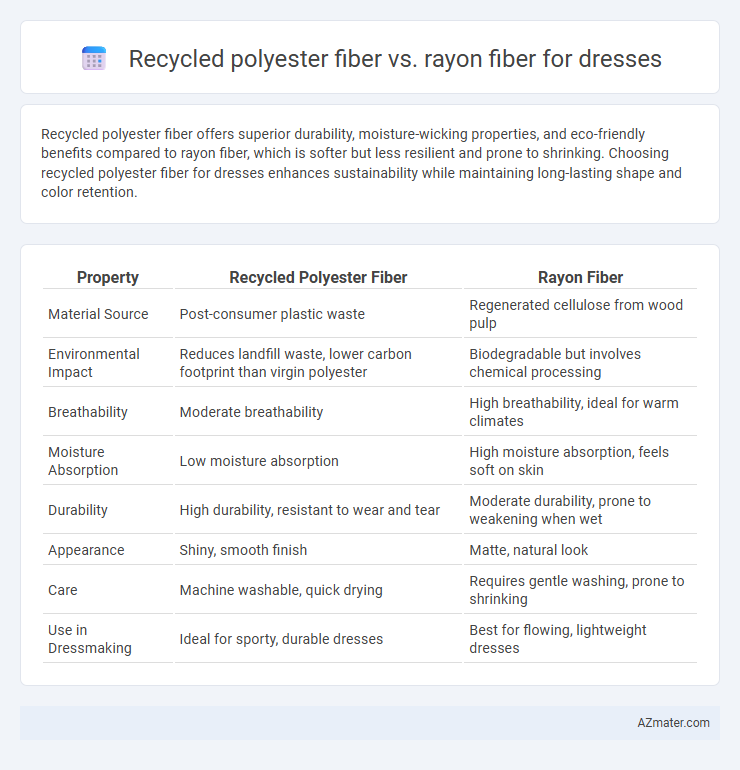Recycled polyester fiber offers superior durability, moisture-wicking properties, and eco-friendly benefits compared to rayon fiber, which is softer but less resilient and prone to shrinking. Choosing recycled polyester fiber for dresses enhances sustainability while maintaining long-lasting shape and color retention.
Table of Comparison
| Property | Recycled Polyester Fiber | Rayon Fiber |
|---|---|---|
| Material Source | Post-consumer plastic waste | Regenerated cellulose from wood pulp |
| Environmental Impact | Reduces landfill waste, lower carbon footprint than virgin polyester | Biodegradable but involves chemical processing |
| Breathability | Moderate breathability | High breathability, ideal for warm climates |
| Moisture Absorption | Low moisture absorption | High moisture absorption, feels soft on skin |
| Durability | High durability, resistant to wear and tear | Moderate durability, prone to weakening when wet |
| Appearance | Shiny, smooth finish | Matte, natural look |
| Care | Machine washable, quick drying | Requires gentle washing, prone to shrinking |
| Use in Dressmaking | Ideal for sporty, durable dresses | Best for flowing, lightweight dresses |
Introduction to Recycled Polyester Fiber and Rayon Fiber
Recycled polyester fiber is a sustainable textile made from post-consumer plastic bottles and industrial polyester waste, offering durability, moisture-wicking, and resistance to wrinkles for dress fabric applications. Rayon fiber, derived from natural cellulose sources such as wood pulp, provides a soft, breathable, and highly absorbent material ideal for comfortable and elegant dress designs. Both fibers contribute uniquely to sustainable fashion, with recycled polyester emphasizing eco-friendly material reuse and rayon focusing on biodegradability and natural fiber benefits.
Overview of Sustainable Dress Materials
Recycled polyester fiber, made from post-consumer plastic bottles, offers a durable and eco-friendly alternative to traditional synthetic fibers by reducing landfill waste and energy consumption. Rayon fiber, derived from natural cellulose sources like wood pulp, provides a biodegradable and breathable fabric option but often involves intensive chemical processing that can impact sustainability. Choosing between recycled polyester and rayon fibers for sustainable dresses involves balancing recycled content and biodegradability with environmental manufacturing practices.
Production Process: Recycled Polyester vs Rayon
Recycled polyester fiber is produced by melting and re-spinning post-consumer plastic waste, primarily PET bottles, reducing reliance on petroleum and minimizing landfill impact. Rayon fiber is manufactured through a chemically intensive process, involving the dissolution of cellulose from wood pulp in hazardous solvents like carbon disulfide, which raises environmental and health concerns. The sustainable advantage of recycled polyester lies in its circular production process and lower energy consumption compared to rayon's high water use and deforestation-related raw material sourcing.
Environmental Impact Comparison
Recycled polyester fiber significantly reduces environmental impact by minimizing waste and lowering greenhouse gas emissions compared to virgin polyester production, while rayon fiber, derived from wood pulp, contributes to deforestation and involves chemically intensive processing that can lead to water pollution. The closed-loop production process in recycled polyester enables resource efficiency and lessens landfill dependency, contrasting with traditional rayon production methods that often lack sustainable forestry practices. Overall, recycled polyester offers a more eco-friendly alternative to rayon fiber for dress manufacturing when prioritizing sustainable material sourcing and pollution reduction.
Comfort and Wearability in Dresses
Recycled polyester fiber offers superior durability and moisture-wicking properties, making it highly suitable for comfortable, long-lasting dresses. Rayon fiber is known for its soft, breathable texture that enhances wearability in warm conditions but tends to wrinkle and lose shape more quickly. Choosing between recycled polyester and rayon depends on desired dress performance, with recycled polyester excelling in resilience and moisture management, while rayon prioritizes softness and breathability.
Durability and Maintenance
Recycled polyester fiber exhibits superior durability compared to rayon fiber, resisting wear, shrinkage, and stretching, which ensures longer-lasting dresses. Maintenance for recycled polyester is easier, as it is wrinkle-resistant, quick-drying, and retains color better after multiple washes, unlike rayon that often requires delicate handling and dry cleaning to prevent damage. This makes recycled polyester fiber a more practical choice for dress materials where longevity and easy care are priorities.
Cost Considerations for Dress Manufacturers
Recycled polyester fiber typically offers a lower cost per yard compared to rayon fiber, making it an attractive option for dress manufacturers aiming to reduce production expenses. The manufacturing process of recycled polyester is more energy-efficient and less resource-intensive, contributing to overall cost savings. Rayon fiber, while often favored for its softness and drape, generally involves higher raw material and processing costs, increasing the final garment price for manufacturers.
Aesthetic Qualities: Texture, Drape, and Color Retention
Recycled polyester fiber offers a smooth texture with excellent drape, maintaining vibrant color retention even after multiple washes, making it ideal for long-lasting dresses. Rayon fiber provides a soft, natural feel with a fluid drape that enhances garment elegance but tends to fade faster and wrinkle more easily. In terms of aesthetics, recycled polyester excels in durability and color vibrancy, while rayon stands out for its luxurious hand and graceful movement.
Consumer Preferences and Market Trends
Recycled polyester fiber is favored by consumers seeking sustainable and durable dress materials, offering high resistance to wrinkles and ease of care, while rayon fiber appeals to those prioritizing softness, breathability, and a natural feel. Market trends indicate a growing demand for recycled polyester due to its eco-friendly attributes and compatibility with fast fashion, whereas rayon maintains steady popularity in luxury and summer wear for its drape and comfort. Emerging innovations in recycled polyester production and increased brand transparency are accelerating its adoption, reflecting a shift towards environmentally conscious consumer preferences.
Choosing the Right Fiber for Eco-Friendly Dresses
Recycled polyester fiber offers durability, moisture-wicking properties, and a lower environmental impact by reusing plastic waste, making it ideal for sustainable dresses. Rayon fiber, derived from cellulose, provides a soft, breathable, and biodegradable option but involves chemically intensive production processes. Selecting the right eco-friendly fiber depends on balancing durability and environmental footprint, with recycled polyester excelling in waste reduction and rayon favored for natural comfort and biodegradability.

Infographic: Recycled polyester fiber vs Rayon fiber for Dress
 azmater.com
azmater.com